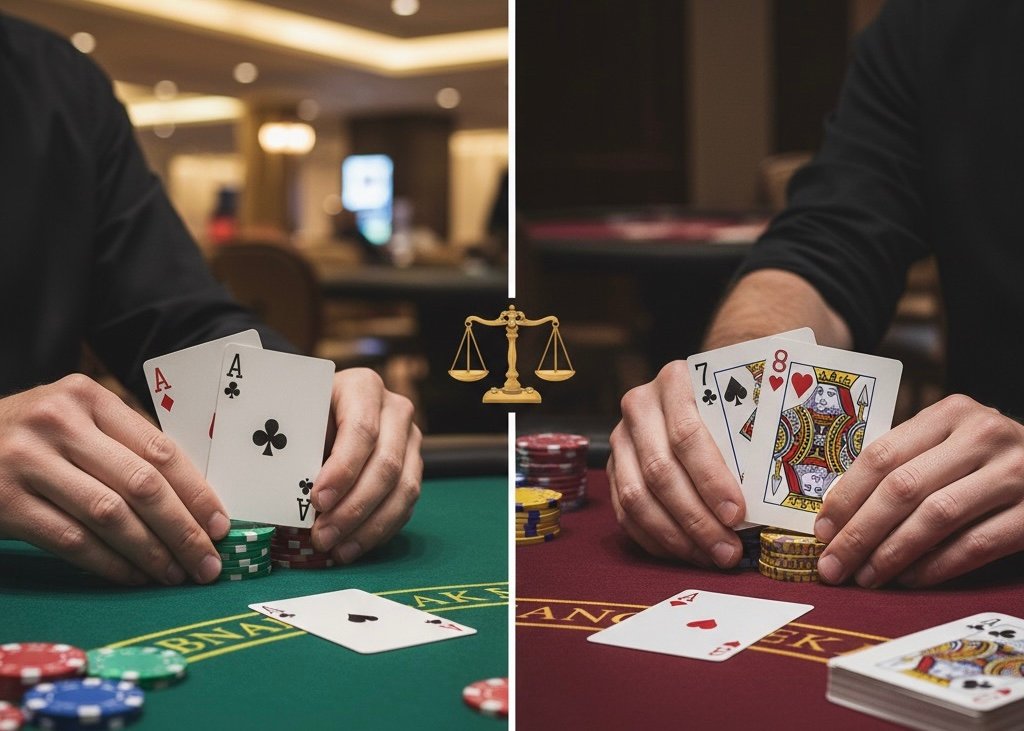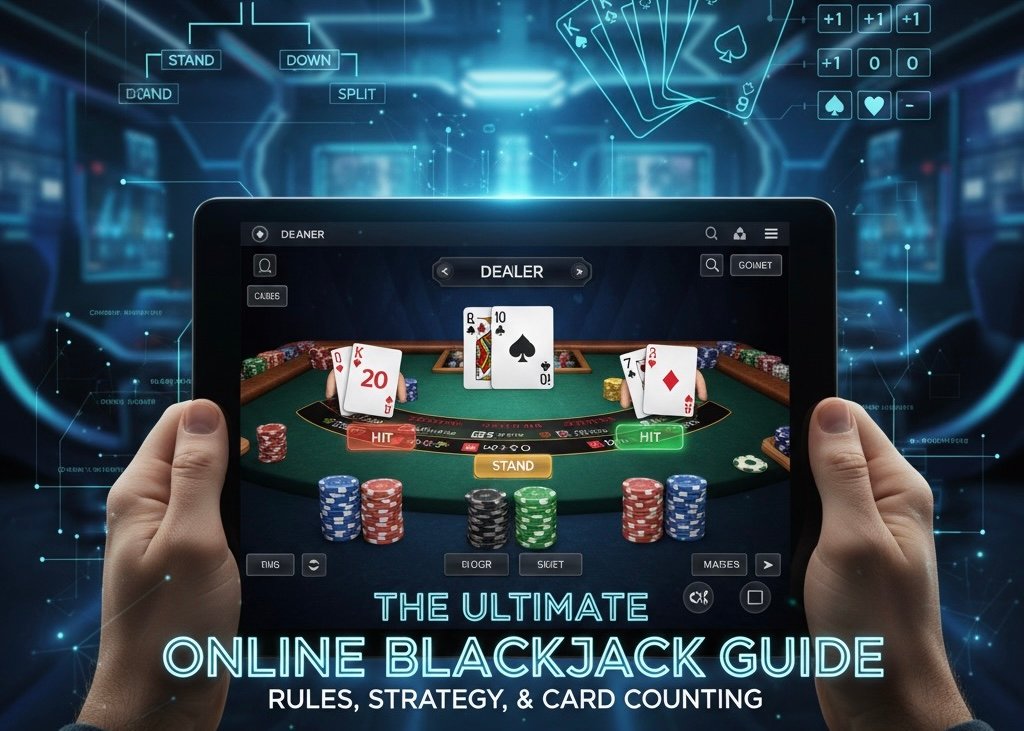Key Takeaways
- Deck Composition: Spanish 21 removes all four numeric 10 cards from the deck, significantly altering the probability of busting and the house edge compared to standard Blackjack.
- Player-Friendly Rules: To compensate for the missing 10s, Spanish 21 offers rules like “player 21 always wins,” late surrender, and “double down rescue,” which are rarely found in traditional games.
- Bonus Payouts: Unlike standard Blackjack, Spanish 21 provides fixed bonus payouts for specific hands (e.g., 6-7-8 or 7-7-7), adding a layer of volatility and excitement to the strategy.
For decades, Blackjack has stood as the undisputed sovereign of the casino floor. Its blend of low house edge and strategic depth makes it a staple for serious players. However, experienced gamblers know that not all 21 games are created equal. Spanish 21 (often known as “Pontoon” in Australian casinos, though rules differ slightly) offers a compelling, high-action alternative that challenges the dominance of the traditional game.
At The Casino Count, we often see players confuse the two, assuming that basic strategy applies universally. It does not. While the objective—beating the dealer without exceeding 21—remains identical, the structural differences in deck composition and payout mechanics create two mathematically distinct experiences. This guide examines the key differences between Blackjack and Spanish 21 to ensure you approach the table informed and prepared.
The Spanish Deck: The Critical Difference
The most profound difference lies in the equipment itself. Standard Blackjack is played with a standard 52-card deck (or multiple decks of 52). In contrast, Spanish 21 is played with 48-card decks.
The missing cards are the four numeric 10s. The face cards (Kings, Queens, Jacks) remain and are still valued at 10, but the actual 10-spot cards are removed.
Why This Matters
Removing the 10s is mathematically devastating for the player. In standard Blackjack, a deck rich in 10-value cards favours the player because it increases the likelihood of:
- Being dealt a natural Blackjack (which pays 3:2).
- The dealer busting on stiff hands (12-16).
By stripping the numeric 10s, the house edge in Spanish 21 would skyrocket to an unplayable percentage if standard rules were applied. To entice players back to the table, casinos introduce a suite of extremely liberal, player-favourable rules that do not exist in the classic version.
Rule Variations Comparison
When you learn how to play Blackjack in an online casino, you are taught rigid rules regarding splitting and doubling. Spanish 21 throws many of these restrictions out the window.
1. Player 21 Always Wins
In standard Blackjack, if both the player and the dealer hit 21, the result is a “push” (a tie), and your bet is returned. In Spanish 21, a player’s 21 always beats a dealer’s 21. Furthermore, a player’s Blackjack beats a dealer’s Blackjack. This rule alone is a significant morale booster and bankroll preserver.
2. Doubling Down and Splitting
Standard Blackjack usually restricts doubling down to totals of 9, 10, or 11, and resplitting Aces is often forbidden. Spanish 21 is far more permissible:
- Double on any number of cards: You can double down even after taking three or four hits.
- Redouble: Some venues allow you to double down again after already doubling (Double-Double).
- Split Aces: Players can usually split Aces and then draw, double, or surrender—actions typically barred in standard games.
3. The “Double Down Rescue”
This is a unique safety mechanism in Spanish 21. If you double down and are dealt a poor card (leaving you with a stiff total), you can choose to “rescue” the doubled portion of your bet. You forfeit the original wager but save the double bet, effectively surrendering half your total commitment after seeing the bad card.
4. Late Surrender
While some standard Blackjack tables offer surrender, it is a guaranteed feature in Spanish 21. If the dealer does not have a Blackjack, you may surrender half your bet and fold your hand. This is statistically vital when facing a dealer’s Ace or face card with a hard 15 or 16.
Bonus Payouts: The Volatility Factor
Standard Blackjack payouts are binary: you win even money (1:1) or you hit Blackjack (3:2 or, unfortunately, 6:5 at some tables). Spanish 21 introduces fixed odds payouts for specific card combinations, regardless of the dealer’s hand.
These payouts generally do not apply if you have doubled down, but they offer significant upside during normal play:
- 5-Card 21: Pays 3:2
- 6-Card 21: Pays 2:1
- 7+ Card 21: Pays 3:1
- 6-7-8 or 7-7-7 (Mixed Suits): Pays 3:2
- 6-7-8 or 7-7-7 (Same Suit): Pays 2:1
- 6-7-8 or 7-7-7 (Spades): Pays 3:1
There is also the “Super Bonus.” If you hold suited 7-7-7 and the dealer hits a 7 face-up, payouts can range from £1,000 to £5,000 depending on the bet size, and all other players at the table often receive an “Envy Bonus.” This introduces a community jackpot element absent from traditional Blackjack.
House Edge and RTP Analysis
Many players assume Spanish 21 has a higher house edge due to the missing 10s. However, because of the liberal rules mentioned above, the House Edge can actually be lower than standard Blackjack if played with perfect strategy.
- Standard Blackjack: Depending on the specific table rules (dealer hits/stands on soft 17, number of decks), the House Edge typically ranges from 0.5% to 2.0%.
- Spanish 21: With optimal strategy, the House Edge is often around 0.4% to 0.76% (variances occur depending on whether the dealer hits on Soft 17).
However, the key phrase is “optimal strategy.” Because the game is more complex, the risk of player error is significantly higher in Spanish 21. A player applying standard Blackjack strategy to a Spanish 21 table will face a much higher disadvantage.
Strategic Adjustments: You Cannot Play Autopilot
If you are looking to transition from our Beginners Corner to Spanish 21, you will need to unlearn certain habits.
Hitting vs Standing
Because the deck lacks 10s, the probability of busting is lower. Consequently, you must play more aggressively against these hands.
- Hard 12: In standard Blackjack, you stand against a dealer 4, 5, or 6. In Spanish 21, you generally hit a hard 12 against a dealer 4.
- Soft Hands: You will find yourself hitting soft 18s much more frequently in Spanish 21 because you cannot rely on a 10 popping out of the shoe to strengthen your hand.
Chasing Bonuses
Occasionally, strategy dictates chasing the bonus payouts. For example, if you have a 6-7-8 suited, optimal play might suggest hitting or standing differently than the basic math suggests to secure the higher payout. However, be cautious; chasing bonuses blindly is a quick way to erode your bankroll.
Summary Comparison: Blackjack vs. Spanish 21
To visualise the distinctions, here is a breakdown of the core features:
Standard Blackjack
- Deck: 52 cards (10s included).
- Dealer 21: Pushes with player 21.
- Surrender: Rare/Rule dependent.
- Doubling: Restricted (often 9-11 only).
- Payouts: Standard 1:1 or 3:2.
Spanish 21
- Deck: 48 cards (10s removed).
- Dealer 21: Player 21 always wins.
- Surrender: Allowed late surrender; Double Down Rescue available.
- Doubling: Allowed on any number of cards.
- Payouts: Standard 1:1 plus bonus payouts for 5+ card 21s and 6-7-8/7-7-7 combos.
Which Game Should You Play?
The choice between Blackjack and Spanish 21 depends on your risk tolerance and willingness to learn complex strategies.
Choose Standard Blackjack if:
- You prefer a lower variance game.
- You want to memorise a simpler basic strategy chart.
- You prefer the traditional pace and math of the classic game.
- You are a card counter (Counting systems in Spanish 21 are notoriously difficult and less effective due to the missing 10s).
Choose Spanish 21 if:
- You enjoy more “action” and decision-making per hand.
- You find the bonus payouts and jackpot potential exciting.
- You dislike the frustration of “pushing” on a 21.
- You are willing to learn a more complex strategy chart to achieve a potentially lower house edge.
Conclusion
While both games share a lineage, they require distinct mindsets. Standard Blackjack is a game of grinding out small edges through disciplined math. Spanish 21 is a game of leverage—using the flexible rules to navigate around the disadvantage of a 10-less deck.
For those new to casino gaming, we recommend starting with standard Blackjack to master the fundamentals of hand value and dealer mechanics. You can find comprehensive guides on our blog to get you started. Once you are comfortable, Spanish 21 offers a thrilling evolution of the concept, provided you adjust your tactics accordingly.
If you have specific questions about rule variations or would like us to cover a particular strategy, please contact the team at info@thecasinocount.com.
To truly master the tables, you need to look beyond individual tactics and understand how every mechanic interacts. For a complete deep dive into the mathematics, advanced plays, and professional bankroll management, read our comprehensive pillar article: The Ultimate Online Blackjack Guide: Rules, Strategy & Card Counting.
Disclaimer: Gambling involves risk. Please gamble responsibly. The house always retains a mathematical edge in the long run.




Leave a Reply